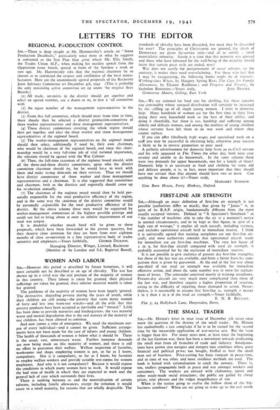FIRST-LINE AIR STRENGTH
Sta,—Although an exact definition of first-line air strength is not possible (authorities differ so much), that given by " Janus " is, in spite of its R.A.F. origin, fundamentally different from the more usually accepted versions. Defined in " A Spectator's Notebook " as " the number of machines able to take the air at a moment's notice in normal circumstances, and to be kept at that figure, in spite of a high rate of wastage," it implies all such aircraft, including trainers, and excludes operational aircraft held in immediate reserve. I think it is universally agreed that training aeroplanes are not first-line air- craft; and most authorities consider that operational aircraft ready for immediate use are first-line machines. The very low figure of I in 9, for first-line aircraft compared with total air strength, is probably accounted for by the exclusion of immediate -eserves.
It is not possible to give statistics of present day first-line strengths; but those of the last war are available, and form a better basis for com- parison than is given by guesswork. At the end of the last war about one-third of our total air strength was available for immediate offensive action, and about the same number was in store for replace- ment of losses. The remainder consisted mostly of training aeroplanes. Present-day aircraft are very much more complicated than those of the last war, and therefore require a higher proportion of reserves, owing to the difficulty of repairing those damaged in action. Never- theless, it is reasonable to assume that first-line a4 strength is nearer I in 3 than I in 9 of the total air strength.—Yours faithfully,






















 Previous page
Previous page